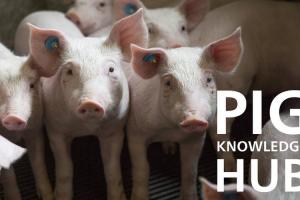Weaning strategies for pig performance
Piglets should be weaned at an appropriate age and body weight to ensure that they continue their desired growth curve. Poor growth, immaturity and high variability within the litter can lead to variation in performance as the piglets progress through the grower and finisher phases, causing increases in costs at slaughter. This may negate the “all-in/all-out” (AIAO) strategy used on many farms, in which pigs reach age when they have reached finished weight.
All piglets should be checked at weaning
Monitoring weight gain immediately before weaning is important to make sure that there are no growth issues in the first seven days after weaning. Several strategies can be implemented to avoid problems with subsequent performance.
All piglets should be checked at weaning to ensure target and uniform weights are attained. The manager can either group piglets by litters or by body weight; both groups have pros and cons, so the choice should be consistent across litters.
During the first four days after weaning, specific attention to the housing environment is essential to eliminate cold spots and draughts. Solid boards, rather than slatted floors, should be used.
All weaned piglets must have free access to clean water
They should also be provided with highly digestible feed that they find palatable. The feed should be soaked with water for the first two days to encourage intake.
Feed should be offered in enough open dishes to allow free access for all the animals during the first three days post-weaning. Troughs should be large enough to supply feed to all piglets after this date. Poor access to feed can lead to smaller animals being excluded from feeding.
Use a highly digestible and palatable diet
Diets should include proven enzyme supplementation to enhance digestion, as well as products such as Actigen®, which will balance microflora and contribute to good gut health at this important time. Specialist ingredients, such as nucleotides, can be used to promote the development of the digestive tract. Creep feed should be available little and often throughout the day — perhaps four or five times — and any refusals or stale feed should be discarded.
Group the pigs by weight
Seven days or so after weaning, any small piglets should be removed and placed together in a separate pen within the same house. They should be maintained on the creep diet for longer to allow their body weight to catch up with their siblings. Any in-feed medication prescribed by a veterinarian should be administered during the first 10 days after weaning.
Use different diets according to body weight and age
As the piglets progress in age and weight, diets must be adjusted to match their changing requirements. The environment needs to be controlled and changed accordingly (e.g., temperature). This will prevent the development of respiratory and other diseases as well as help maintain optimal conditions for growth and health.
Feeding age-and weight-appropriate diets with proven zootechnical ingredients to promote digestive function and the ideal gut environment are crucial to the development and efficiency of the intestinal tract. Without the appropriate diet, or if the pigs are exposed to gut pathogens, the villi that line the gut may be damaged. This may lead to atrophy and poor endogenous enzyme secretions, poor mucous protection and reduced nutrient absorption. Because only minimal amounts of feed are consumed during the pre-weaning period, attention to detail during this stage is important for the health and productivity of the animals until slaughter age.
Key factors dictate the degree of villus atrophy
Several factors affect the chances of the piglet developing atrophied villi after weaning. The age and weight at weaning is important, as this is a measure of the animal’s maturity and ability to cope with weaning stresses. Environmental factors within the house are also important; if not controlled correctly, it can add further stress to the piglet and make it more susceptible to disease.
Feed should be palatable and highly digestible to ensure that it is digested in the upper ileum and does not bypass enzyme breakdown, which can result in the feed flowing into the hind gut, where it will act as a substrate for non-beneficial bacteria. This can lead to the development of gastrointestinal disease. Certainly, protein is important in this respect, as bypassed protein can be utilized by toxic bacteria such as Clostridia spp. Feed and water hygiene will help reduce the introduction of many pathogens into the piglets, and whilst feed is often monitored, water troughs and water quality may not always be. Many pathogens are transmitted via dirty water systems.
To arrange a complimentary Alltech Pig ASSIST audit for your herd, please contact us at pigsolutions@alltech.com.


